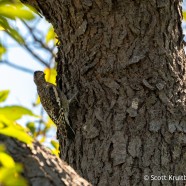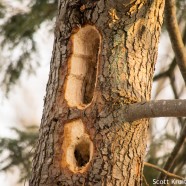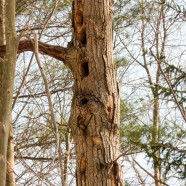Yellow-bellied Sapsucker
Oh man, here we go again, another Yellow-bellied Sapsucker (Sphyrapicus varius) looking like bark! This individual is surrounded by wells that it and others of its species have drilled, one of many such trees in an orchard in a town park. This wintering area is obviously a productive spot and when you can look like a tree all day long, even if you’re an occasionally louder than usual tree, no one is going to bother you.
Read MoreBark or Bird?
What do you see here? If the scene were in the darker shade that it was in real life, without this edited photo, you might simply see a tree. I never realized how much juvenile Yellow-bellied Sapsuckers (Sphyrapicus varius) look like bark! I suppose that helps to give them a little privacy when they are drilling into it while feeding and in a stationary, somewhat vulnerable position for a prolonged period of time. In this case this migrant bird was moving around looking for something a little more suitable at a stopover site. Have you found a Sapsucker in your yard this month? So many birds...
Read MorePileated Woodpecker Holes
These are some extra fresh Pileated Woodpecker holes! That wood looks like it has been cut very recently, and it certainly looks like a professional job. Whenever you see a dead or dying tree in your yard please try to leave it there if possible – if it is not infected with something such as Hemlock Woolly Adelgid, or a particularly dangerous falling hazard to people. It will end up serving a host of species that depend on these decaying plants for food, shelter and nesting. Cutting even these trees down solely for aesthetic purposes is robbing the environment of a vital component....
Read MorePileated Woodpecker Signs
Here is another telltale bird sign that you can find rather easily in the winter. Any guesses as to what species made these massive marks on this tree? The Pileated Woodpecker is a large, crow-size bird and as such it creates astonishingly huge holes with its big bill. Even though they are conspicuous birds when seen they can be tough to find in the first place because they have such large territories. If you cannot see them flashing by through mature woodlands try listening for their laughing call or finding these reminders of their presence.
Read More







